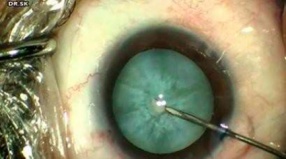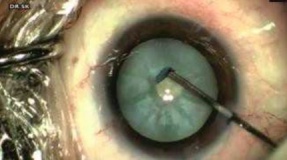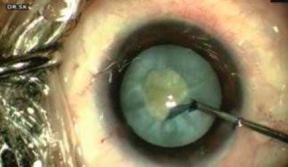Can-Vac CCC (Cannula-Vacuum Continuous Curvilinear Capsulorhexis): A Novel Approach for Capsulorhexis
From EyeWiki
All content on Eyewiki is protected by copyright law and the Terms of Service. This content may not be reproduced, copied, or put into any artificial intelligence program, including large language and generative AI models, without permission from the Academy.
All contributors:
Assigned editor:
Review:
Assigned status Update Pending
Can-Vac CCC is a novel technique for capsulorhexis. It is safe, simple and useful in challenging cataract cases, particularly intumescent cataract. It is also effective in routine cataract cases. This article describes the surgical procedure and clinical applications of this novel technique.
Introduction
- Cataract surgery is one of the most common surgeries performed worldwide. Ability to perform a safe capsulorhexis is paramount to success in any cataract surgery.[1][2] Historically, many technqiues of performing capsulorhexis has been described in literature.[3][4][5] [6][7][8][9][10][11][12][13][14][15][16][17]However, modern day cataract surgeons employ continuous curvilinear capsulorhexis (CCC) as their preferred method.[5][6]
- Can-Vac CCC is the latest innovation in the domain of capsulorhexis that is safe, simple and useful to perform in some of the most challenging cataract cases.[18][19]
Principle and Novelty of technique
Principle
- Novel Can-Vac CCC uses vacuum suction generated at the cannula tip by the piston of the syringe as the primary mechanism for creating rhexis during cataract surgery.[18][19]
Novelty
- A 25-gauge cannula provides an appropriate bore size, just adequate for grasping the free rhexis flap.
- The tip which is neither too small nor too large, provides ample suction and does not lead to excessive viscoelastic aspiration or flap amputation respectively.[18][19]
Surgical procedure
Instrumentation
- A 25 gauge rounded/flat blunt tipped cannula attached to a 5ml syringe is required for Can-Vac CCC.
Surgical steps
- Initially a 26 gauge needle cystitome is used to create a nick in the anterior lens capsule and raise a small flap.
- The Can-Vac cannula tip is then introduced into the anterior chamber (preferably from the side port incision).
- The free edge of the rhexis flap is held with this cannula tip by the suction force generated by manually withdrawing the syringe piston.
- The flap is then grasped and re-grasped by regulating the suction pressure through manual manipulation of the syringe piston. This maneuvre is continued in a circular fashion to create a well formed CCC of desired size.
- Any loose cortex or milky lens fluid (in patients with intumescent cataract) released during the process can be withdrawn by the cannula into the syringe obviating the need for repeated instrumentation and thus helping a clear visual field for surgery.
- The whole process can be completed in a single step of instrumentation without any need for repeated viscoelastic injection and also avoiding any chamber collapse.
Indications
- Intumescent cataract, where there is high intralenticular pressure and risk of Argentina Flag sign and run off rhexis.
- Total and hypermature cataract.
- Immature cataract.
Advantages
- A novel inexpensive technique
- Easy availablility
- Reusable
- Reproducible
- Obviates the need for repeated instrumentation including repeated injection of viscoelastics
- Lesser chances of chamber fluctuation and risk of rhexis run off
- Provides a clear operating field by helping aspiration of the liquefied cortex (in patients with intumescent cataract).
Limitations
- Initial technical difficulty with the learning curve.
Additional resources
- We suggest the readers to watch the link below to get a visual understanding of this technique.
References
- ↑ Carifi G, Miller MH, Pitsas C, Zygoura V, Deshmukh RR, Kopsachilis N. Complications and outcomes of phacoemulsification cataract surgery complicated by anterior capsule tear. Am J Ophthalmol 2015;159:463‑9.
- ↑ Oner FH, Durak I, Soylev M, Ergin M. Long‑term results of various anterior capsulotomies and radial tears on intraocular lens centration. Ophthalmic Surg Lasers 2001;32:118‑23.
- ↑ Kwitko M, Simcoe W. Manual extracapsular surgery. In: Marvin L Kwitko, Charles D Kelman, editor. The history of modern cataract surgery. The Netherlands: Hague; Kugler publishers; 1998. p. 91-106.
- ↑ Haigh PM, Habib N, King AJW, David DB. Modified capsulorhexis vs. envelope capsulotomy in extracapsular cataract surgery. Eur J Implant Refract Surg 1995;7:291‑4.
- ↑ Jump up to: 5.0 5.1 Gimbel HV, Neuhann T. Development, advantages, and methods of the continuous circular capsulorhexis technique. J Cataract Refract Surg 1990;16:31‑7.
- ↑ Jump up to: 6.0 6.1 Gimbel HV, Neuhann T. Continuous curvilinear capsulorhexis. J Cataract Refract Surg 1991;17:110‑1.
- ↑ Arshinoff S. Mechanics of capsulorhexis. J Cataract Refract Surg 1992;18:623‑8.
- ↑ Gimbel HV. Two staged capsulorhexis for endocapsular phacoemulsification. J Cataract Refract Surg 1990;16:246‑9.
- ↑ Pham DT, Liekfeld A, Hartmann C. Capsulotomy in intumescent cataract with the high frequency diathermy capsulotomy. Klin Monbl Augenheilkd 1998;212:29‑31.
- ↑ Dada T, Sethi H. Forceps capsulorhexis. J Cataract Refract Surg 2002;28:1491.
- ↑ Kara‑Junior N, de Santhiago MR, Kawakami A, Carricondo P, Hida WT. Mini rhexis for white intumescent cataracts. Clinics (Sao Paulo) 2009;64;309‑12.
- ↑ Malik KPS, Goel R, Bimanual capsulorrhexis using Sinskey hook. Contact lens & anterior eye. J Br Contact Lens Assoc 2012;35:228‑9.
- ↑ Powers MA, Kahook MY. New device for creating a continuous curvilinear capsulorhexis. J Cataract Refract Surg 2014;40:822‑30.
- ↑ Kranitz K, Takacs A, Mihaltz K. Femtosecond laser capsulotomy and manual continuous curvilinear capsulorrhexis parameters and their effects on intraocular lens centration. J Refract Surg 2011;27:558‑63.
- ↑ Friedman NJ, Palanker DV, Schuele G. Femtosecond laser capsulotomy. J Cataract Refract Surg 2011;37:1189‑98.
- ↑ Chang DF, Mammalis N. Precision pulse capsulotomy preclinical safety and performance of a new capsulotomy technology. Ophthalmology 2016;123:255‑64.
- ↑ Chang DF. Zepto precision pulse capsulotomy: A new automated and disposable capsulotomy technology. Indian J Ophthalmol;65:1411‑4.
- ↑ Jump up to: 18.0 18.1 18.2 Kodavoor SK, Deb B, Ramamurthy D. A Novel Inexpensive Rhexis Technique-Can Vac Ccc for Immature and White Intumescent Cataract - Our Experience. International Journal of Ophthalmology & Visual Science 2020;5:53-6.
- ↑ Jump up to: 19.0 19.1 19.2 Kodavoor SK, Deb B, Ramamurthy D. A Novel Inexpensive Rhexis Technique-Can Vac Ccc for Immature and White Intumescent Cataract - Our Experience. International Journal of Ophthalmology & Visual Science 2020;5:53-6.




